Market View for 2023 & beyond
We are close to ending 2022 and at this juncture it seems that the markets will close in the positive for the 7th consecutive year. The last time we saw a similar 7 year consecutive gain was between 1988 to 1994.
The high of 1994 was next broken only in 1999. I hope that we won’t see a repeat of that but who knows how the future shall unfold. Politically 94 was the peak of strong governance and the period following that was one of political instability not to mention international financial crises such as the 1997 Asean Financial crisis.
At the current juncture, it seems that political stability will be there for at least the next few years and while there are countries which have been brutally hammered by Covid and are facing financial strain, the impact on the world economy at large should be moderate.
To understand the future trajectory of the economy, one way is to study the economic trajectory of other countries which have similarities in India.
Let’s start with next door, Pakistan and China. First a comparison with Pakistan. GDP per Capita is a data point that can be easily compared across countries, large or small. Here is the one comparing India’s GDP per capita with Pakistan’s GDP per capita.
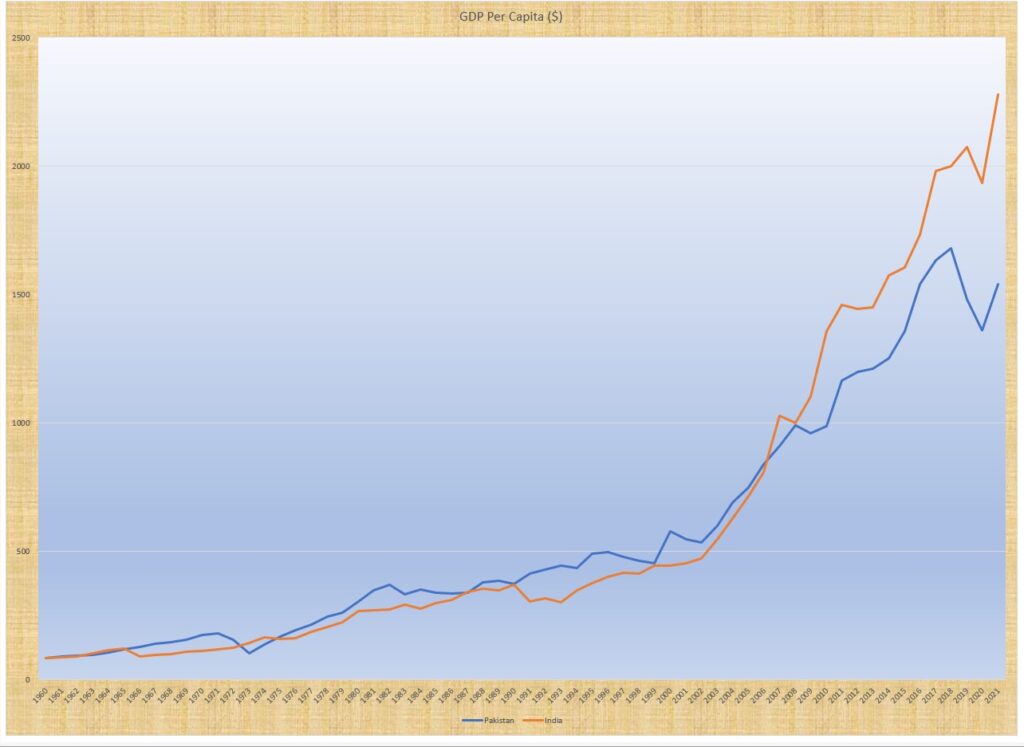
The surprising part of this chart – Pakistan till 2017 had more or less consistently had a higher GDP per capita than India. Today, India’s is 48% higher and based on data, it seems it can only become wider.
Another country that India can and should be compared is with China. I had to use log chart here just to ensure that the Indian line was visible enough, such has been the growth of China.
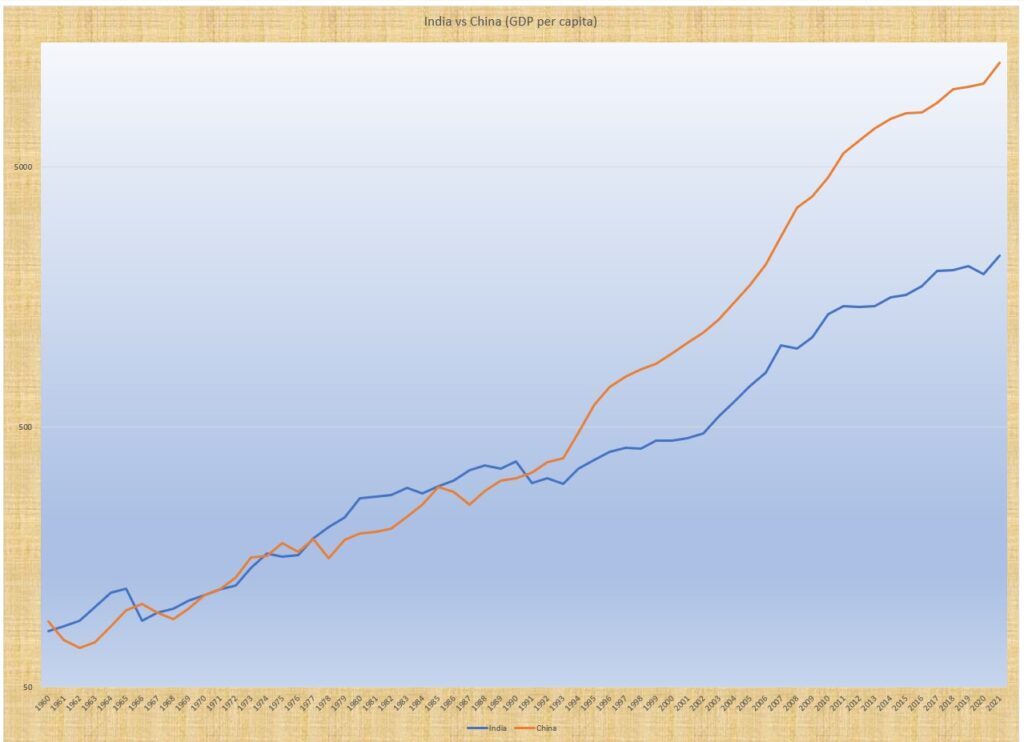
The surprising aspect of this chart is that China was lower than India till 1991. Given India was lower than Pakistan, China seems to have been even worse. Then it took off. Today, China is 450% higher than India. India today is at the same place where China was way back in 2004 / 2005.
But Indian trajectory of growth vs Pakistan did not start in 2007. It was the result of all the reforms carried out since 1991. Same for China, China’s crossover in 1991 over India happened due to more than a decade of even stronger reforms and one that for now continues to bear fruit.
While I barely read Indian newspapers, I make it a point to try and read Pakistan’s (especially the Open-Ed columns). The optimist I am, I think the Indian path will mirror China’s (even though we may never grow as fast and as long as them) but the realist also wonders, what if we slip up.
In one of my previous blog posts, I wrote this
“Assume you were a rich Pakistani. You understand that inflation is high, real Interest rates are negative and hence investing in the stock markets is a better way. At the beginning of 2018, the KSE Index was at 41,000 and One USD cost 112 Pakistan Rupees. Today, the Index is at similar levels, one USD is now available 220. Basically in USD terms, the wealth has halved over a period of just 5 years”
Since 2004, Nifty 50 has gone up by 840% whereas the same Nifty 50 denominated in USD has gone up by just around 415%. A 50% decline in returns.
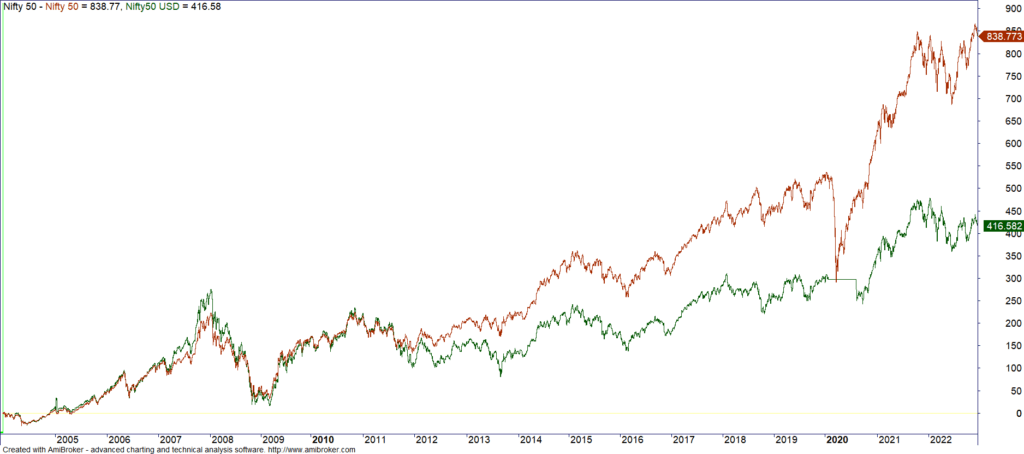
Why worry about USD returns when our earnings and spending is all in Rupees you may wonder. The reason is simple, Energy cost is calculated in USD and as the base accounts for much of the price rise in every product.
While India may never become the manufacturing powerhouse that China / Germany are today, Manufacturing shall drive growth in addition to the growth powered by Services. United Nations Industrial Development Organization ranks India at 40 with most trends seeing a accelerating trend since the 1990’s when the data starts
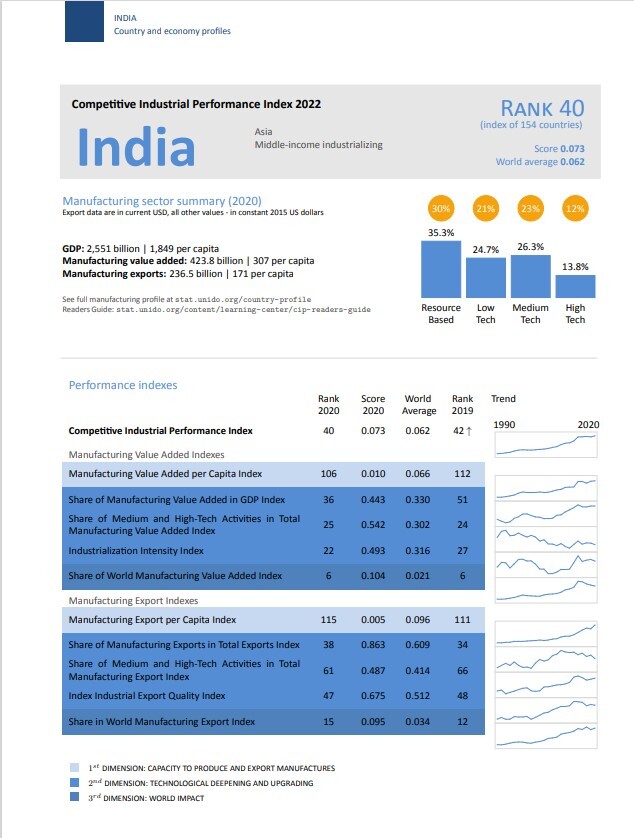
Countries make mistakes, mistakes that may not be noticeable immediately but have profound impact in the years to come. I believe Europe has made some really bad calls and the price will be paid by their citizens over the coming years and even decades. Nothing goes away scott free.
I am not in the game of prediction and yet, I predict. Prediction to me is important to have an understanding of the future to decide what course of action is best suited to allow me to live the quality of life I wish to lead.
India today I think is at a very sweet spot. Yes, there are risks especially from the North but given the recent experience of Russia with Ukraine, I feel the situation will not go down the tubes anytime soon.
The US markets have seen pretty tough days with S&P 500 giving away nearly all the gains made in 2021. Nasdaq has gone even further giving up not just the returns of 2021 but nearly half of the gains made in 2020. A bit more decline and we could see the Index being close to where it was pre-corona.
Take a look at the ratio chart of S&P 500 vs Nifty 50 in USD
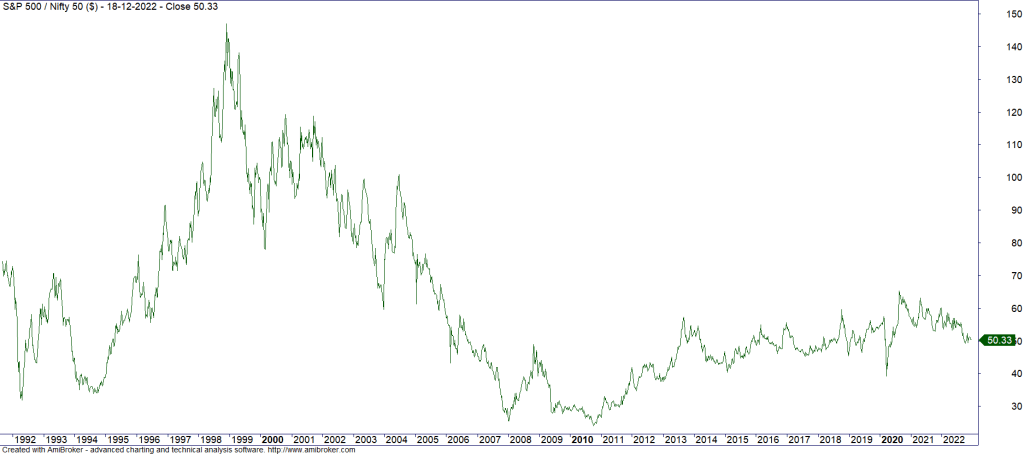
India underperformed big time vs US from 1994 to 1998. From there to the end of 2007, it was one way of outperformance. This even though both the Indian and US markets took a hit when the dotcom bubble melted.
Since 2013, Indian Markets and US have been in tune in US Dollar terms. Measured in local currency terms, S&P 500 is up by 131% vs 231% for Nifty 50. Kind of shows the impact of the depreciation of the Rupee vs the Dollar
The continued rise in Interest rates in the US has hit most countries with even the Euro and the British Pound unable to stem the tide of depreciated currency. Japan’s Yen has depreciated by more than 20% this year alone.
From 1973 to 2000, the Indian Rupee saw a CAGR depreciation of 6.67% to the USD. From 2000 to 2010, the Indian Rupee barely moved. From 2010 to today, its annual depreciation is to the tune of 5.24%. 2022 seems to be in line to be the 11th worst since 1973. Unless India can get to a situation where we have a trade surplus, this depreciation is bound to continue
In the last few months, there have been hundreds of reports of the coming decades and even maybe the century. I am an optimist and really wish for that to happen but unlike China which was in the right place at the right time, it will be tough for India to replicate the act.
Globalization which used to be promoted by the West is now being seen as a negative given how dependent they have come to be on China and the hollowing out of manufacturing. While global trade will continue to grow, the competition is really hot.
The biggest advantage for India vs other countries lies in the large population which provides for a huge local market. But the local market size has been trumpeted for nearly 20 years now but when it comes to consumption, we are still a pygmy.
Currently more than 50% of stocks listed on the NSE are outperforming Nifty 50. While this is not on the higher side, if historical data is any evidence, this also rules out another bull market starting anytime soon

Same is the case with the % of stocks trading above the 200 EMA
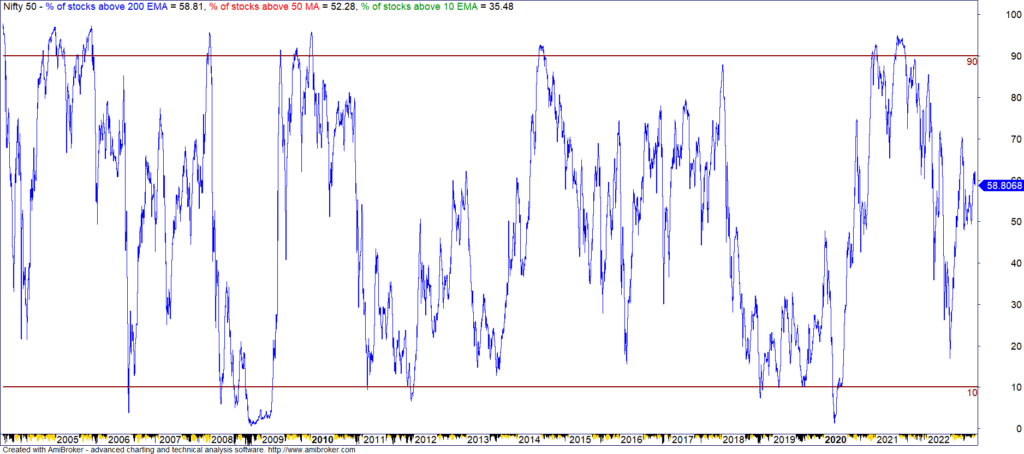
This year, the Nifty Small Cap Index saw a decent correction. But unlike say 2018 or going back, 2011, this isn’t deep enough to provide a platform for the next jump.
When we talk about correction, we always assume price correction for in majority of the cases, its price correction that sets the base for the next leg of the rally. This induces a fear that the next big correction is on the cards. What we seem to be seeing in the current instance though is more of time correction.
From India’s perspective, the Russia-Ukraine war has not had a major negative impact on the economy. While we did face some tumultuous times due to oil spiking up, today with oil trading well below $80, it has become more comfortable to manage. Same cannot be said for a host of other countries.
Based on trailing four quarter earnings, Valuations are neither cheap nor expensive. Kind of no man’s land for now.

Reasons for the 2000 crash or the 2008 crash did not originate in India. If the world catches a cold, it’s unlikely that we can stay insulated. The low interest rate prodded rallies in both Private Equity and Crypto are beginning to peter out. Will the massive reset and losses have no impact on the public equities? Only time can give the answer.
Prediction for 2023
While there are still two weeks to go, markets weren’t kind to the prediction that was evolving at the end of 2021. Here is the comparison with what really happened. As can be seen, the prediction really did not counter the deep cut we saw in the middle of this year and unless we see a decent rally in the coming two weeks, it is unlikely to close near the predicted levels.
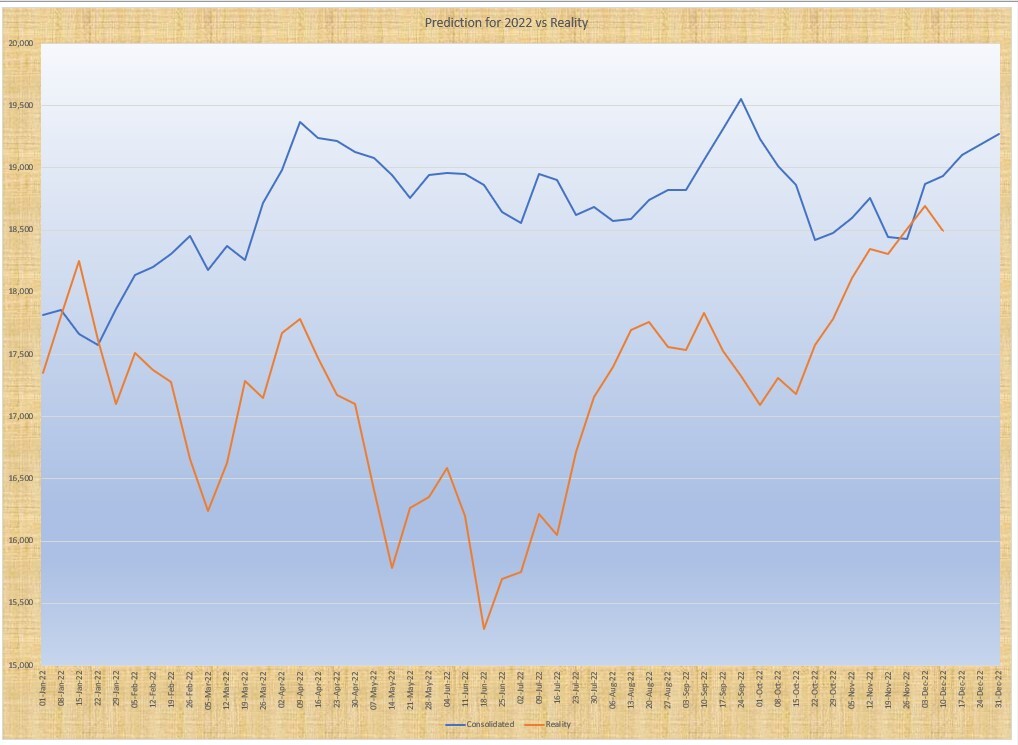
Based on my understanding and analysis of cycle theory, this is how I assume 2023 will evolve.




Recent Comments